Notes: Wednesfield was situated on the eight-mile double-track Wolverhampton and Walsall Railway (W&W) which was authorised on 29 June 1865. The line took seven years to build, opening on 1 November 1872. It was intended that from the opening of the line it would be worked by the London & North Western Railway (LNWR) and the Midland Railway (MR).
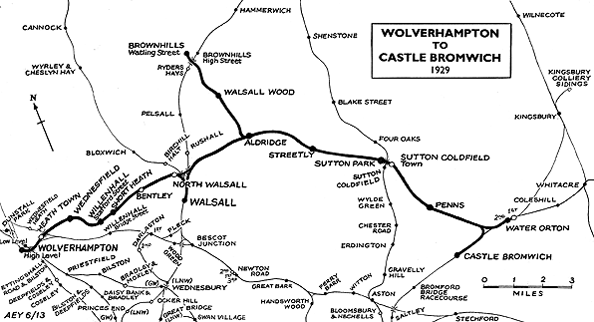
Wednesfield opened with the line on 1 November 1872. It was located on the west side of Neachells Lane which passed over the line on a bridge. The main facilities were in a two-storey, brick-built structure on the up (Walsall direction) platform. There were two adjoining sections, each with its gable at right angles to the platform, that at the eastern end being much smaller in extent and lower than its neighbour, and recessed from the platform. A single-storey range with a bay window extended westwards from the larger two-storey section. On the down platform a pent-roofed brick waiting shelter was provided.
Goods facilities included sidings and a timber-built goods shed located to the north of the passenger station. A signal box, located on the south side of the line to the west of the down platform, controlled the main line and access to the goods yard.
Wednesfield was a manufacturing centre, and private sidings were provided for a number of local industries.
At the time of opening Wednesfield would have been served by trains running between Wolverhampton High Level station and Walsall, both of which were in LNWR ownership.
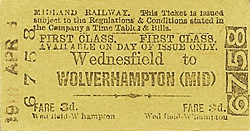 In 1875 the LNWR bought the W&W, but a year later sold it to the MR. The MR was interested in the W&W because it had taken over the Wolverhampton, Walsall & Midland Junction Railway (WW&MJR) in 1874. The WW&MJR had, with MR support, been authorised on 6 August 1872 to build a line from Castle Bromwich/Water Orton (on the MR main line between Birmingham and Derby) to Walsall that also made an end on connection with the W&W line. The Castle Bromwich line opened on 1 July 1879 giving the MR direct access to Wolverhampton. In 1875 the LNWR bought the W&W, but a year later sold it to the MR. The MR was interested in the W&W because it had taken over the Wolverhampton, Walsall & Midland Junction Railway (WW&MJR) in 1874. The WW&MJR had, with MR support, been authorised on 6 August 1872 to build a line from Castle Bromwich/Water Orton (on the MR main line between Birmingham and Derby) to Walsall that also made an end on connection with the W&W line. The Castle Bromwich line opened on 1 July 1879 giving the MR direct access to Wolverhampton.
From this date Wednesfield was served by trains running between Birmingham New Street and Wolverhampton High Level via Walsall (where reversal was necessary).
The December 1895 timetable showed Wednesfield as having ten up and ten down services on Monday-to-Friday. There was an extra up service on Saturdays and three services in each direction on Sundays.
| Up Trains December 1895 |
Destination |
Down trains December 1895 |
Destination |
| 8.33am |
Birmingham New Street |
8.05am |
Wolverhampton High Level |
| 10.20am |
Birmingham New Street |
8.59am |
Wolverhampton High Level |
| 12.15pm |
Birmingham New Street |
11.07am |
Wolverhampton High Level |
| 1.28pm |
Birmingham New Street |
12.48pm |
Wolverhampton High Level |
| 3.43pm (Wednesdays Excepted) |
Birmingham New Street |
2.11pm |
Wolverhampton High Level |
| 3.53pm (Wednesdays Only) |
Birmingham New Street |
3.05pm |
Wolverhampton High Level |
| 5.17pm |
Birmingham New Street |
5.12pm |
Wolverhampton High Level |
| 6.54pm |
Birmingham New Street |
6.18pm |
Wolverhampton High Level |
| 8.08pm |
Birmingham New Street |
8.18pm |
Wolverhampton High Level |
| 9.06pm |
Walsall |
9.51pm |
Wolverhampton High Level |
| 10.53pm |
Walsall |
10.56pm (Saturdays Only) |
Wolverhampton High Level |
| 11.25pm (Saturdays Only) |
Walsall |
|
|
In January 1909 the MR diverted most of its Birmingham and Wolverhampton trains to run between Walsall and Wolverhampton via an LNWR route that had been created by the opening of connecting curves in 1881. The reason for the diversion was to avoid run-round moves at Walsall but it resulted in a much reduced passenger service at Wednesfield. To compensate some LNWR trains ran via the MR route. By doing so they could avoid a reversal at Walsall but one that had been in the opposite direction to that of the MR trains.
The April 1910 timetable showed Wednesfield as having five MR and three LNWR services in each direction Monday-to-Friday. On Saturdays there were an extra two MR services in each direction and on Sundays there were four trains each way. By December 1922 the service had reduced further there being only four up and three down trains Monday-to-Saturday. Interestingly there were three up and two down trains on Sundays.
On 1 January 1923 the LNWR and the MR became part of the London Midland & Scottish Railway. The LMS further concentrated the passenger services over the former LNWR route and withdrew it completely from Wednesfield (and from the other surviving intermediate stations on the former W&W line) on 5 January 1931. Wednesfield station remained open for goods.
On 1 January 1948 Wednesfield became part of British Railways London Midland Region. The former W&W continued to be a busy freight route throughout the 1950s, but it closed as a through route on 28 September 1964. The line was broken at the site of Bentley station to facilitate the construction of the M6 motorway.
The section of line through Wednesfield, from Heath Town Junction to Willenhall, remained in use for goods services until 4 October 1965 after which it was closed completely.
The track remained in situ, and the line from Heath Town Junction to a point just to the east of Wednesfield station reopened in the early part of 1970 to serve a large works built by the Weldless Steel Tube Company at Wednesfield. The works was to the west of the station on the north side of the line.
The station and its goods shed were extant at the time of the reopening as was the signal box, but all were in a derelict condition and had been demolished by 1978.
Trains ran to the works as trip workings until 1983 after which the line was closed completely and lifted. By 2013 a road had been constructed on the site of the station and little remained to show there had been a railway at Wednesfield.
Tickets from Michael Stewart, timetable from Chris Totty and route map by Alan Young.
Sources:
To see other stations on the Castle Bromwich and Wolverhampton line click on the station name: Castle Bromwich, Penns, Sutton Coldfield Town, Sutton Park, Streetly, Aldridge, North Walsall, Bentley, Short Heath,
Willenhall Stafford Street and Heath Town
See also Brownhill branch stations: Walsall Wood and Brownhills
|

.jpg)
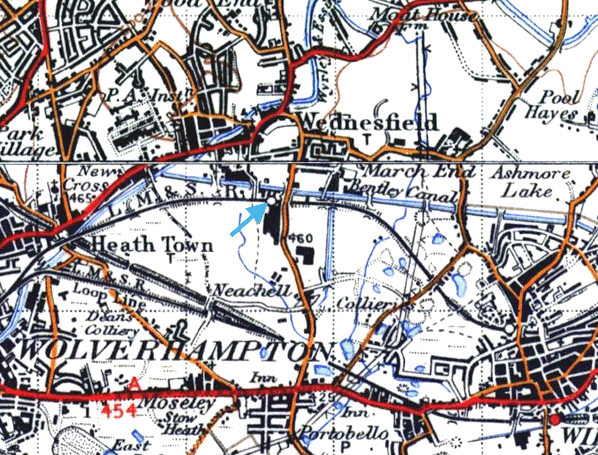
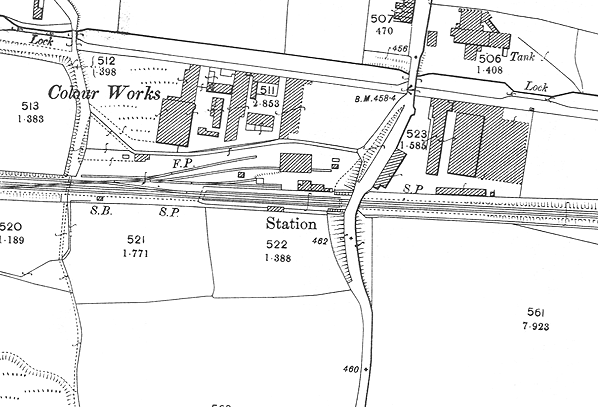
.jpg)
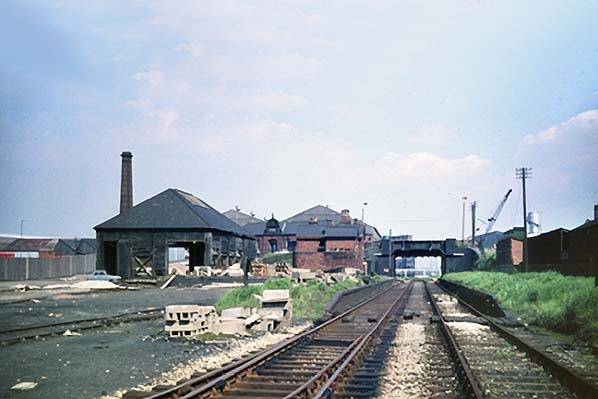
5.jpg)
1.jpg)
7.jpg)
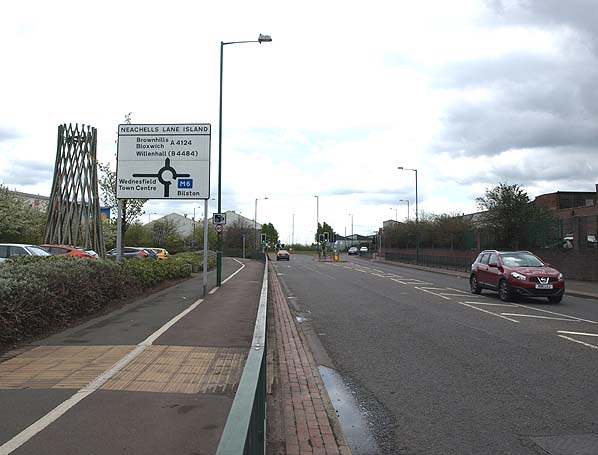
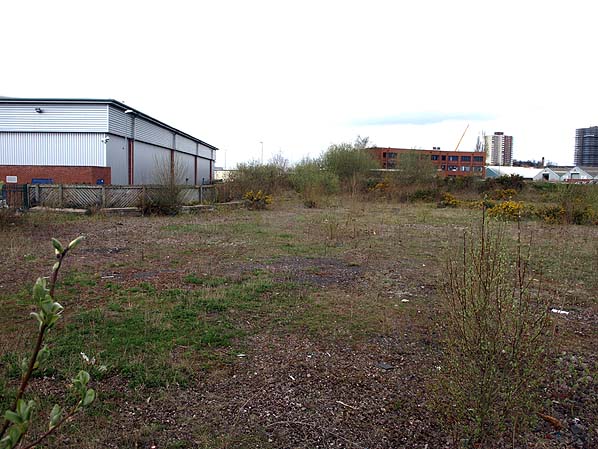

 In 1875 the LNWR bought the W&W, but a year later sold it to the MR. The MR was interested in the W&W because it had taken over the Wolverhampton, Walsall & Midland Junction Railway (WW&MJR) in 1874. The WW&MJR had, with MR support, been authorised on 6 August 1872 to build a line from Castle Bromwich/Water Orton (on the MR main line between Birmingham and Derby) to Walsall that also made an end on connection with the W&W line. The Castle Bromwich line opened on 1 July 1879 giving the MR direct access to Wolverhampton.
In 1875 the LNWR bought the W&W, but a year later sold it to the MR. The MR was interested in the W&W because it had taken over the Wolverhampton, Walsall & Midland Junction Railway (WW&MJR) in 1874. The WW&MJR had, with MR support, been authorised on 6 August 1872 to build a line from Castle Bromwich/Water Orton (on the MR main line between Birmingham and Derby) to Walsall that also made an end on connection with the W&W line. The Castle Bromwich line opened on 1 July 1879 giving the MR direct access to Wolverhampton. 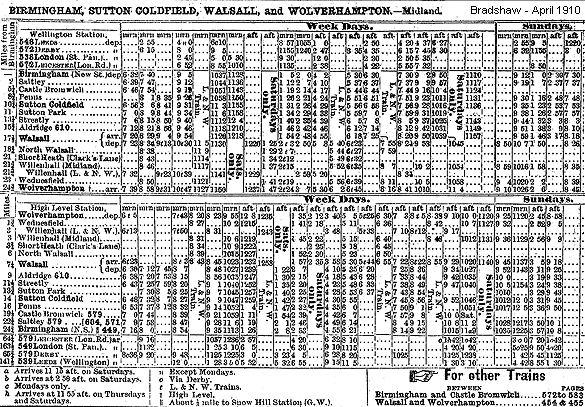
2.jpg)
3.jpg)
4.jpg)
6.jpg)

 Home Page
Home Page